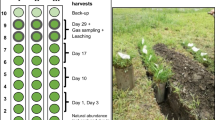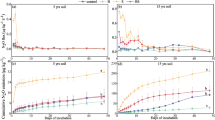Abstract
Aims
Agricultural soils in semiarid Mediterranean areas are characterized by low organic matter contents and low fertility levels. Application of crop residues and/or manures as amendments is a cost-effective and sustainable alternative to overcome this problem. However, these management practices may induce important changes in the nitrogen oxide emissions from these agroecosystems, with additional impacts on carbon dioxide emissions. In this context, a field experiment was carried out with a barley (Hordeum vulgare L.) crop under Mediterranean conditions to evaluate the effect of combining maize (Zea mays L.) residues and N fertilizer inputs (organic and/or mineral) on these emissions.
Methods
Crop yield and N uptake, soil mineral N concentrations, dissolved organic carbon (DOC), denitrification capacity, N2O, NO and CO2 fluxes were measured during the growing season.
Results
The incorporation of maize stover increased N2O emissions during the experimental period by c. 105 %. Conversely, NO emissions were significantly reduced in the plots amended with crop residues. The partial substitution of urea by pig slurry reduced net N2O emissions by 46 and 39 %, with and without the incorporation of crop residues respectively. Net emissions of NO were reduced 38 and 17 % for the same treatments. Molar DOC:NO −3 ratio was found to be a robust predictor of N2O and NO fluxes.
Conclusions
The main effect of the interaction between crop residue and N fertilizer application occurred in the medium term (4–6 month after application), enhancing N2O emissions and decreasing NO emissions as consequence of residue incorporation. The substitution of urea by pig slurry can be considered a good management strategy since N2O and NO emissions were reduced by the use of the organic residue.






Similar content being viewed by others
References
Alexander M (1977) Mineralization and immobilization of nitrogen. In: Alexander M (ed) Introduction to soil microbiology, 2nd edn. Wiley, New York, pp 136–247
Anderson IC, Levine JS (1986) Relatives rates of nitric oxide and nitrous oxide production by nitrifiers, denitrifiers and nitrate respires. Appl Environ Microbiol 51:938–945
AOAC (2000) Association of official analytical chemists, official methods of analysis (17th edn), Washington, DC
Aulakh MS, Doran JW, Walters DT, Mosier AR, Francis DD (1991) Crop residue type and placement effects on denitrification and mineralization. Soil Sci Soc Am J 55:1020–1025
Baggs EM, Rees RM, Smith KA, Vinten AJA (2000) Nitrous oxide emission from soils after incorporating crop residues. Soil Use Manag 16:82–87
Bellarby J, Foereid B, Hastings A, Smith P (2008) Cool farming: climate impacts of agriculture and mitigation potential. Greenpeace International, Amsterdam, 44 p
Bouwman AF, Boumans LJM, Batjes NH (2002) Modeling global annual N2O and NO emissions from fertilized fields. Global Biogeochem Cycles 16: art.no.1080 doi:10.1029/2001GB001812
Cayuela ML, Sinicco T, Mondini C (2009) Mineralization dynamics and biochemical properties during initial decomposition of plant and animal residues in soil. Appl Soil Ecol 41:118–127
Chadwick DR, Pain BF, Brookman SKE (2000) Nitrous oxide and methane emissions following application of animal manures to grassland. J Environ Qual 29:277–287
Clayton H, Arah JRM, Smith KA (1994) Measurement of nitrous oxide emissions from fertilized grassland using closed chambers. J Geophys Res 99:16599–16607
Constantinides M, Fownes JH (1994) Tissue to solvent ratio and other factors affecting determination of soluble polyphenols in tropical leaves. Commun Soil Sci Plant 25:3221–3227
Danielson RE, Sutherland PL (1986) Porosity. In: Klute A (ed) Methods of soil analysis. Physical and mineralogical methods. American Society of Agronomy, Madison, pp 443–460
Das SK, Subba Reddy G, Sharma KL, Vittal KPR, Venkateswarlu B, Reddy MN, Reddy YVR (1993) Prediction of nitrogen availability in soil after crop residue incorporation. Fertil Res 34:209–215
Dittert K, Lampe C, Gasche R, Butterbach-Bahl K, Wachendorf M, Papen H, Sattelmacher B, Taube F (2005) Short-term effects of single or combined application of mineral N fertilizer and cattle slurry on the fluxes of radiatively active trace gases from grassland soil. Soil Biol Biochem 37:1665–1674
Drury CF, McKenney DJ, Findlay WI (1991) Relationships between denitrification, microbial biomass and indigenous soil properties. Soil Biol Biochem 23:751–755
Flessa H, Beese F (1995) Effect of sugarbeet residues on soil redox potential and nitrous oxide emission. Soil Sci Soc Am J 59:1044–1051
Frimpong KA, Baggs EM (2010) Do combined applications of crop residues and inorganic fertilizer lower emission of N2O from soil? Soil Use Manag 26:412–424
Garcia-Gil JC, Plaza C, Soler-Rovira P, Polo A (2000) Long-term effects of municipal solid waste compost application on soil enzyme activities and microbial biomass. Soil Biol Biochem 32:1907–1913
Garcia-Ruiz R, Baggs EM (2007) N2O emission from soil following combined application of fertiliser-N and ground weed residues. Plant Soil 299:263–274
Gentile R, Vanlauwe B, Chivenge P, Six J (2008) Interactive effects from combining fertilizer and organic residue inputs on nitrogen transformations. Soil Biol Biochem 40:2375–2384
Hadas A, Kautsky L, GoekM Kara EE (2004) Rates of decomposition of plant residues and available nitrogen in soil, related to residue composition through simulation of carbon and nitrogen turnover. Soil Biol Biochem 36:255–266
Heal OW, Anderson JM, Swift MJ (1997) Plant litter quality and decomposition: an historical overview. In: Cadisch G, Giller KE (eds) Driven by nature: plant litter quality and decomposition. CAB International, Wallingford, pp 3–30
Huang Y, Zou JW, Zheng XH, Wang YS, Xu XK (2004) Nitrous oxide emissions as influenced by amendment of plant residues with different C:N ratios. Soil Biol Biochem 36:973–981
IPCC (2007) Climate change. In: Synthesis report of the fourth assessment report of IPCC, chapter 3, pp 49
Lampurlanés J, Cantero-Martínez C (2006) Hydraulic conductivity, residue cover and soil surface roughness under different tillage systems in semiarid conditions. Soil Tillage Res 85:13–26
Liu C, Wang K, Meng S, Zheng X, Zhou Z, Han S, Chen D, Yang Z (2011) Effects of irrigation, fertilization and crop straw management on nitrous oxide and nitric oxide emissions from a wheat–maize rotation field in northern China. Agric Ecosyst Environ 140:226–233
Malhi SS, Grant CA, Johnston AM, Gill KS (2001) Nitrogen fertilization management for no-till cereal production in the Canadian Great Plains: a review. Soil Tillage Res 60:101–122
Malhi SS, Nyborg M, Solberg ED, McConkey B, Dyck M, Puurveen D (2011) Long-term straw management and N fertilizer rate effects on quantity and quality of organic C and N and some chemical properties in two contrasting soils in Western Canada. Biol Fertil Soils 47:785–800
Meade G, Lalor STJ, McCabe T (2011) An evaluation of the combined usage of separated liquid pig manure and inorganic fertiliser in nutrient programmes for winter wheat production. Eur J Agron 34:62–70
Meijide A, Díez JA, Sanchez-Martin L, López-Fernández S, Vallejo A (2007) Nitrogen oxide emissions from an irrigated maize crop amended with treated pig slurries and composts in a Mediterranean climate. Agric Ecosyst Environ 121:383–394
Merino A, Pérez-Batallon P, Macias F (2004) Responses of soil organic matter and greenhouse gas fluxes to soil management and land use changes in a humid temperate region of southern Europe. Soil Biol Biochem 36:917–925
Mertens DR (2002) Gravimetric determination of amylase-treated neutral detergent fibre in feeds with refluxing beakers or crucibles: collaborative study. J Assoc Off Anal Chem Int 85:1217–1240
Mulvaney RL, Khan SA, Mulvaney CS (1997) Nitrogen fertilizers promote denitrification. Biol Fertil Soils 24:211–220
OECD (2000) Environmental indicators for agriculture, methods and results, executive summary 2000, Paris, France. http://www.oecd.org/dataoecd/0/9/1916629.pdf
Palm CA, Rowland AP (1997) A minimum dataset for characterization of plant quality for decomposition. In: Cadisch G, Giller KE (eds) Driven by nature: plant litter quality and decomposition. CAB International, Wallingford, pp 379–392
Ravishankara AR, Daniel JS, Portmann RW (2009) Nitrous oxide (N2O): the dominant ozone-depleting substance emitted in the 21st century. Science 326:123–125
Sanchez-Martín L, Vallejo A, Dick J, Skiba UM (2008) The influence of soluble carbon and fertilizer nitrogen on nitric oxide and nitrous oxide emissions from two contrasting agricultural soils. Soil Biol Biochem 40:142–151
Sanchez-Martin L, Dick JL, Bocary K, Vallejo A, Skiba UM (2010a) Residual effect of organic carbon as a tool for mitigating nitrogen oxides emissions in semi-arid climate. Plant Soil 326:137–145
Sanchez-Martin L, Sanz-Cobena A, Meijide A, Quemada M, Vallejo A (2010b) The importance of the fallow period for N2O and CH4 fluxes and nitrate leaching in a Mediterranean irrigated agroecosystems. Eur J Soil Sci 61:710–720
Sanz-Cobena A, Sánchez-Martín L, García-Torres L, Vallejo A (2012) Gaseous emissions of N2O and NO and NO −3 leaching from urea applied with urease and nitrification inhibitors to a maize (Zea mays) crop. Agric Ecosyst Environ 149:64–73
Sarkodie-Addo J, Lee HC, Baggs EM (2003) Nitrous oxide emissions after application of inorganic fertilizer and incorporation of green manure residues. Soil Use Manag 19:331–339
Skiba U, Ball B (2002) The effect of soil texture and soil drainage on emissions of nitric oxide and nitrous oxide. Soil Use Manag 18:56–60
Smith KA, Conen F (2004) Impacts of land management on fluxes of trace greenhouse gases. Soil Use Manag 20:255–263
Snyder CS, Bruulsema TW, Jensen TL, Fixen PE (2009) Review of greenhouse gas emissions from crop production systems and fertilizer management effects. Agric Ecosyst Environ 133:247–266
Soil Survey Staff (1992) Keys to soil taxonomy, 6th edn. USDA, Washington
Staffelbach T, Neftel A, Horowitz LW (1997) Photochemical oxidant formation over southern Switzerland: 2 model results. J Geophys Res 102:23363–23373
Taylor PG, Townsend AR (2010) Stoichiometric control of organic carbon–nitrate relationships from soils to the sea. Nature 464:1178–1181
Vallejo A, Skiba U, García-Torres L, Arce A, López-Fernández S, Sánchez-Martín L (2006) Nitrogen oxides emission from soils bearing a potato crop as influenced by fertilization with treated pig slurries and composts. Soil Biol Biochem 38:2782–2793
van Groenigen JW, Velthof GL, Oenema O, Van Groenigen KJ, Van Kessel C (2010) Towards an agronomic assessment of N2O emissions: a case study for arable crops. Eur J Soil Sci 61:903–913
Vanlauwe B, Wendt J, Diels J (2001) Combined application of organic matter and fertilizer. In: Tian G, Ishida F, Keatinge JDH (eds) Sustaining soil fertility in West Africa. Soil Science Society of America and American Society of Agronomy, Madison, pp 247–279
Yamulki S, Jarvis S (2002) Short-term effects of tillage and compaction on nitrous oxide, nitric oxide, nitrogen dioxide, methane and carbon dioxide fluxes from grassland. Biol Fertil Soils 36:224–231
Yamulki S, Goulding KWT, Webster CP, Harrison RM (1995) Studies on NO and N2O fluxes from a wheat field. Atmos Environ 29:1627–1635
Yao Z, Zhou Z, Zheng X, Xie B, Mei B, Wang R, Butterbach-Bahl K, Zhu J, Yin R (2009) Tillage and crop residue management significantly affects N-trace gas emissions during the non-rice season of a subtropical rice-wheat rotation. Soil Biol Biochem 41:2131–2140
Yeomans JC, Bremner JM, McCarty GW (1992) Denitrification capacity and denitrification potential of subsurface soils. Commun Soil Sci Plant 23:919–927
Acknowledgements
The authors are grateful to the Spanish Ministry of Science and Innovation and the Autonomous Community of Madrid for their economic support through Projects AGL2009-08412-AGR and the Agrisost Project (S2009/AGR-1630), respectively. Jan Willem van Groenigen is supported by a personal VIDI grant from the Netherlands Organization of Scientific Research/Earth and Life Sciences (NWO-ALW). This study would not have been possible without technical assistance from the technicians and researchers at the Department of Chemistry and Agricultural Analysis of the Agronomy Faculty (Technical University of Madrid, UPM). Special thanks to Simon Jeffery for his critical comments on a previous version of the manuscript.
Author information
Authors and Affiliations
Corresponding author
Additional information
Responsible Editor: Per Ambus.
Rights and permissions
About this article
Cite this article
Abalos, D., Sanz-Cobena, A., Garcia-Torres, L. et al. Role of maize stover incorporation on nitrogen oxide emissions in a non-irrigated Mediterranean barley field. Plant Soil 364, 357–371 (2013). https://doi.org/10.1007/s11104-012-1367-4
Received:
Accepted:
Published:
Issue Date:
DOI: https://doi.org/10.1007/s11104-012-1367-4




